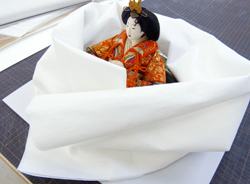News Releases / 2014
-
April 8, 2014
Rengo Develops Gas Q Gas Adsorption Sheets
Excellent Capabilities for Purposes including Cultural Property ProtectionRengo Co., Ltd. (Head Office: Kita-ku, Osaka; Chairman, President & CEO: Kiyoshi Otsubo) announces that it has jointly developed Gas Q gas adsorption sheets together with Archival Conservation and Enclosures Co., Ltd. (Head Office: Bunkyo-ku, Tokyo; President: Toru Kibe). These sheets feature excellent capabilities for purposes including the protection of cultural properties, and utilize Cellgaia, a type of zeolite high-density crystallized pulp material developed by Rengo.
When protecting and conserving cultural properties, issues include damage caused by specific gases in the air, and gases produced by the actual cultural properties, video film and ancient documents, such as ammonia, acetic acid, hydrogen sulfide and volatile organic compounds (VOC). Gas Q is made from materials containing Cellgaia and nonwoven spun lace fabric. This results in excellent adsorbent performance for a wide range of gases, and also guards against organic acids produced by wooden or acidic paper containers used for protection and conservation.Cellgaia is a type of high-function pulp in which zeolite is crystallized inside cellulose fiber at a high density. It contains no binders for zeolite retention, so it offers 100% of the natural functionality of zeolite. In addition, the content can be freely adjusted at high ratios, so there is no loss during usage. Up until now the effects of Cellgaia have been recognized for preventing the sulfurization of silver parts used in electrical appliances and other products, and this material has been adopted for many uses over a long period of time.
To develop Gas Q, Archival Conservation and Enclosures Co., Ltd. —which has many years of experience regarding the conservation of cultural properties—were drawn to the effectiveness of using Cellgaia in creating nonwoven fabric for cultural property conservation. Rengo and Archival Conservation and Enclosures jointly designed this product, and its remarkable effects have been confirmed by various types of testing.Gas Q is unique because it is thinner, lighter, very flexible, and much easier to process than similar conservation sheets of the past, making it possible to safely prevent the deterioration of cultural properties at a low cost. This product has already been adopted at museums, art galleries, libraries, university research archives, and other institutions across Japan. In the future Rengo will continue developing usages for Gas Q in other fields in addition to the protection and conservation of cultural properties, and make efforts to expand this product to overseas markets in which the same issues are experienced.
Examples of using Gas Q gas adsorption sheets


Results of gas adsorption testing
Gas adsorption testing method 1) Each sample was cut into approximately four-millimeter squares, weighed to 1.00 gram and then placed in a special net (made from PE). 2) Each sample was placed in a sampling bag, sealed, and then degassed.
3) Next, 1.5 liters of the gas to be tested (at a specific concentration) was added, and the time-dependent changes of gas concentration in the sampling bag were measured with a detecting tube.

* The data in the graph shows measured values, not guaranteed values. Values will fluctuate according to environmental conditions and other factors when using this product in actual environments.